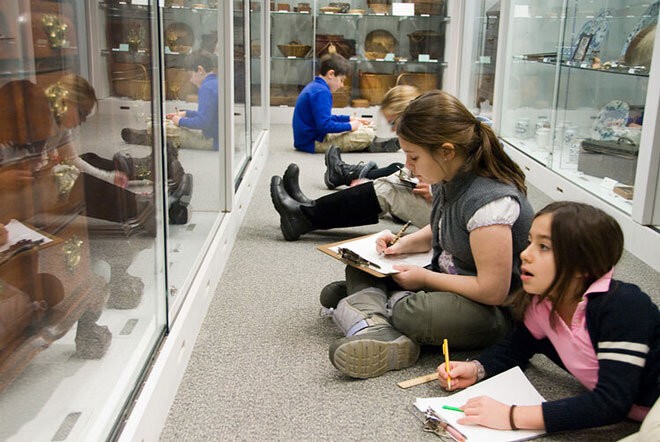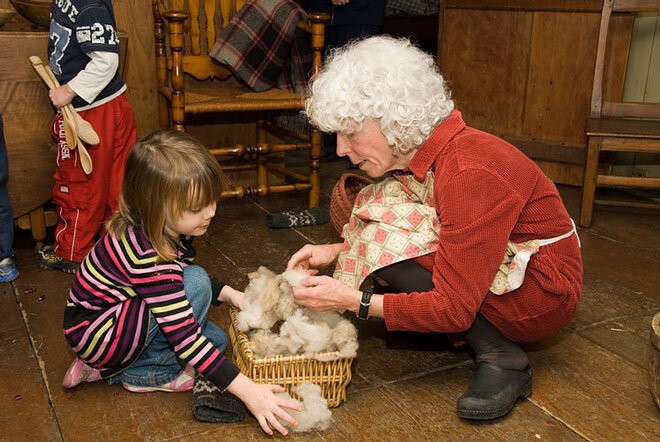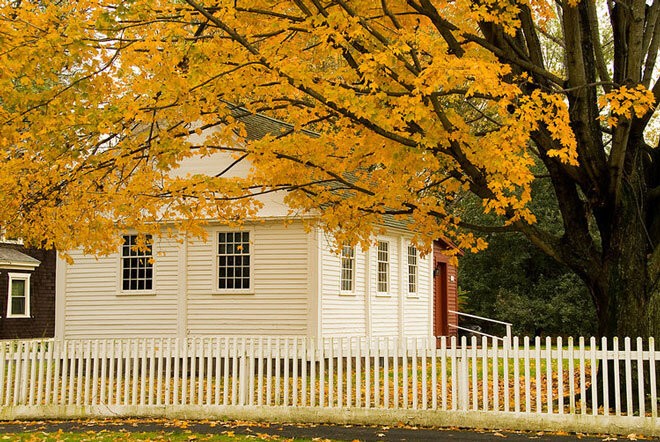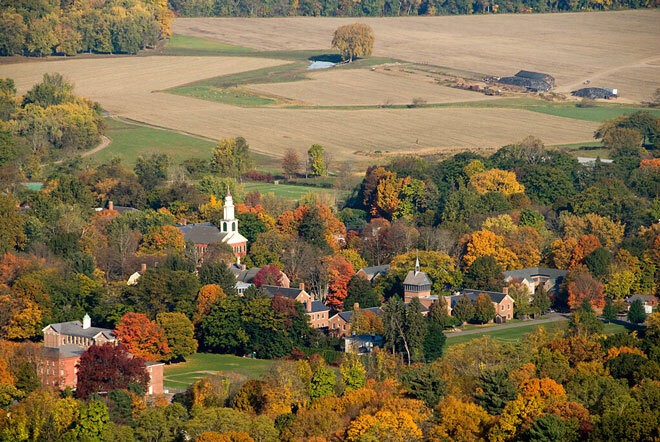EXPERIENCING AMERICAN HISTORY
Our programs feature experiences with real objects in a real place. Getting close to primary sources like buildings, landscape and artifacts provides a tangible connection to the past. On tours, students are guided to strengthen their visual literacy and critical thinking skills through careful observation of historic spaces and the objects that furnish them. Student learning is enhanced when they participate in activities that engage multiple senses: they may card wool, weave on a loom, feel the warmth of the hearth fire, or enjoy the aroma of herbs growing in the cooks’ garden. Some programs feature a craft or project that students may take back to the classroom.
Field Trips to Historic Deerfield
Our museum’s educational programs are designed to offer teachers and students a chance to explore American history in a rural New England village setting. The activities enhance classroom learning through access to primary sources, historic artifacts, and buildings, and are aligned with the Massachusetts Curriculum Frameworks and the Common Core.
Place-Based Learning
Students in grades K-12 discover what life might have been like in the farming community of Deerfield in the 18th and early 19th centuries through active learning. Our programs feature hands-on, skills-based lessons that improve visual literacy, critical thinking, and connecting the past with the present. Content emphasizes teamwork, observation, and analytical skills as students explore in a village landscape Historic Deerfield’s unique collection of historic houses and artifacts.
Historic Deerfield’s educational programs offer teachers and students a chance to explore American history in a rural New England village setting through the following K-12 school programs:

EXPLORE THE PAST
(gr. 3–8) provides students with an opportunity to experience many aspects of 18th-century life through active learning. The journey back to the past includes:
-
An interpreted walk through the village to the one-room schoolhouse where the students will write with quill pen and ink
-
A guided scavenger hunt at the home of the Sheldons, a farm family who lived in the house between 1780 and 1810
-
A hands-on fibers and textile experience that includes carding wool and weaving
-
An open-hearth cooking lesson where students learn to read an historic recipe and help the cook prepare a baked dish.

BE A MUSEUM CURATOR
(gr. 7–12) is designed to teach middle and high school students how to use primary sources and objects to design an exhibit based on objects in Historic Deerfield’s collection. Students will:
-
Tour the galleries at the Flynt Center of Early New England Life
-
Handle reproduction objects and work collaboratively using critical thinking and analytical skill to organize them into thematic groups
-
Design an exhibit where they think creatively about topics and write descriptive exhibition labels
-
Students may continue to work virtually on their exhibit back at school by using Historic Deerfield’s online collections database.

COLONIAL LIFE LONG AGO
(Gr. K–2) is designed for younger students to learn about life in the past. Activities are paced to provide interactive and engaging instruction and can include:
-
Carding wool
-
Helping to mix batter or churn butter in the kitchen
-
Reading a story with hands-on props
-
Playing games
-
Making a simple craft
-
This program can include a visit to the One Room Schoolhouse.

A DAY IN A ONE-ROOM SCHOOLHOUSE
(Gr. 2–6) teaches aspects of daily life and history in early 19th-century New England through an immersive experience in one of our historic buildings, the 1839 Wapping Schoolhouse. The school day is conducted by a Museum Guide much as it would have been in the early 1800s and includes lessons in reading, recitation, spelling, and math.
TAKE YOUR CLASS TO THE SCHOOLHOUSE:
Elementary school teachers are invited to bring their own class to the One Room Schoolhouse and teach their regular class here. We host you and provide quill pens, ink and paper, and slates and chalk. The Classroom Teacher brings their own lessons and teaches them in the 1839 Wapping Schoolhouse. A Museum Guide will assist the teacher and provide instruction for recess games like rolling hoops. Students and teachers are encouraged to come in costume and bring their lunch in a “dinner pail.”

POCUMTUCK HOMELANDS AND ENGLISH HOMELOTS
(Gr. 3 and up) In this program, students explore contrasting concepts of land held by Indigenous people and English colonists.
● Grades 3 and 5 topics can be expanded upon for older students
● Overall field trip duration 3 hours. Each component activity lasts 30 to 45 minutes.
● Maximum of 50 students; larger groups can be accommodated with different, shorter activities.
Pre- and post-visit resources will be provided. A follow-up Zoom call may be scheduled with a Museum Educator.
● A hands-on exercise with reproduction objects important to both Indigenous Pocumtuck people and English colonists invites students to participate in object analysis, to use critical thinking skills, and to explain their ideas verbally to classmates.
● An open-hearth cooking lesson focuses on the adoption of Indigenous food sources by English colonists during the 17th and 18th centuries, in particular corn/maize, as well as beans, squash, and maple sugar.
● Students examine textual primary sources (a map and a deed or an oral tradition) to find evidence for differing cultural beliefs about land and land ownership.
● Students use a guide to identify native and introduced plants along an outdoor footpath, with the option to collect samples for use back in the classroom. During the winter, an alternate walk or activity will engage students with the physical landscape in Deerfield and identify sources and locations of seasonal abundance.
This field trip addresses these Massachusetts 2018 History and Social Science Framework standards:
Grade 3 Content Standards:
● Topic 1.2: “Research the demographic origins of the town or city (e.g. the Native People who originally lived there or are still there, the people who established it as a colonial town, its founding date, and the free, indentured, and enslaved women and men who contributed to the well-being of the town).
● Topic 2: The Geography and Native Peoples of Massachusetts.
T3.2.3d. “contributions of a tribal group from the area of the school (e.g. language, literature, arts, trade routes, food such as corn, beans, and squash, useful items such as baskets, canoes, wampum, and useful knowledge of medicinal plants, words such as powwow and moccasin, and many names for waterways, hill, mountains, islands and place names.
Grade 5 Content Standards
[5.T1] Early Colonization and Growth of Colonies
1. Explain the early relationship of English settlers to native peoples in the 1600s and 1700s, including the impact of diseases introduced by Europeans in severely reducing Native populations, the different views on land ownership or use, property rights, and the conflicts between the two groups (e.g., the Pequot and King Philip’s Wars in New England).

SLAVERY IN 18TH CENTURY DEERFIELD
(Gr. 5 and up) This program is offered in conjunction with Historic Deerfield’s partnership with the Witness Stones Project. This field trip uses Deerfield as a specific site or case-study for the history of slavery in colonial New England. Activities are grounded in primary and secondary source documents as well as objects to provide evidence of the ways in which the system of slavery was an inextricable part of the economic and social development of the town and the region.
Pre- and post-visit resources will be provided. A follow-up Zoom call may be scheduled with a Museum Educator.
● An open-hearth cooking lesson uses food to examine the role of molasses and sugar within the Triangular Trade, imported spices such as ginger, nutmeg, and cinnamon; and provisioning of 18th-century plantations in the Caribbean by New England exports.
● Students explore and handle a collection of tools that illustrate some of the labor of enslaved people in Deerfield as recorded in account books and other written records.
● Students learn about Jenny and her son Cato, enslaved by Deerfield’s minister, Jonathan Ashley. Using secondary source material, students engage in a discussion about their agency and resistance.
● Students work with a partner to analyze a transcript of a written primary source, such as a will, probate inventory, or self-emancipation/runaway ad, to interpret how colonists discussed and thought about slavery.
● References from primary sources such as account books are used to demonstrate the interconnectedness of slavery in all aspects of daily life in 18th century Deerfield. Students represent these relationships with a hands-on group activity.
This field trip addresses these Massachusetts 2018 History and Social Science Framework standards:
Grade 5 United States History to the Civil War and the Modern Civil Rights Movement
Topic 1. Early colonization and growth of the colonies (5.T1.4, T.T1.5, 5.T1.6, 5.T1.7a-d)
5.T1.4 – Map; 13 colonies; regional differences in climate/crops; sources of labor.
5.T1.5 – Origins of slavery, its legal status in all the colonies through the 18th century, and the prevalence of slave ownership.
5.T1.6 – Describe the Triangular Trade and the harsh conditions of trans-Atlantic voyages (called the Middle Passage) for enslaved Africans.
5.T1.7 – Compare and contrast the living and working conditions of enslaved and free Africans in the colonies in the 18th century and explain how some enslaved people sought their freedom.
5.T1.7.a – Enslaved African Americans were property, had no rights, suffered abuse and punishment
5.T1.7.b – Many enslaved Africans became skilled artisans and tradespeople, could be hired out
5.T1.7.c – Some Africans came to America as indentured servants or sailors; freed upon completion of contract; some former enslaved people were granted freedom and some took legal action to obtain freedom
5.T1.7.d – Northern states adopted gradual emancipation; free African Americans could have families, own property, hold jobs, and earn a living
INFORMATION AND RESERVATIONS:
Each field visit to Historic Deerfield is approximately 2.5 hours long with a rotation of prearranged activities. We require one adult for every ten students for grades 3–12, and one adult for every five students for grades Pre-K–2. Adults are expected to assist museum staff with supervision, and must remain with their group at all times. Field trips have a maximum of 50 students with the exception of the One-Room Schoolhouse programs, which has a maximum of 25 students.
Field trips can be customized upon request with additional activities and experiences.
Groups are encouraged to bring a bag lunch and picnic on the grounds outside Hall Tavern where there are picnic tables and public restrooms. There are also tables inside Hall Tavern in case of rain.
Rates: $6 per student. (Minimum field trip program fee is $60 with hearth cooking or $40 without hearth cooking.)
Please contact the School and Family Programs Coordinator at 413-775-7223, or fieldtrips@historic-deerfield.org.
Once your program is confirmed, you will be sent a confirmation letter, information for teachers, and directions to Historic Deerfield.